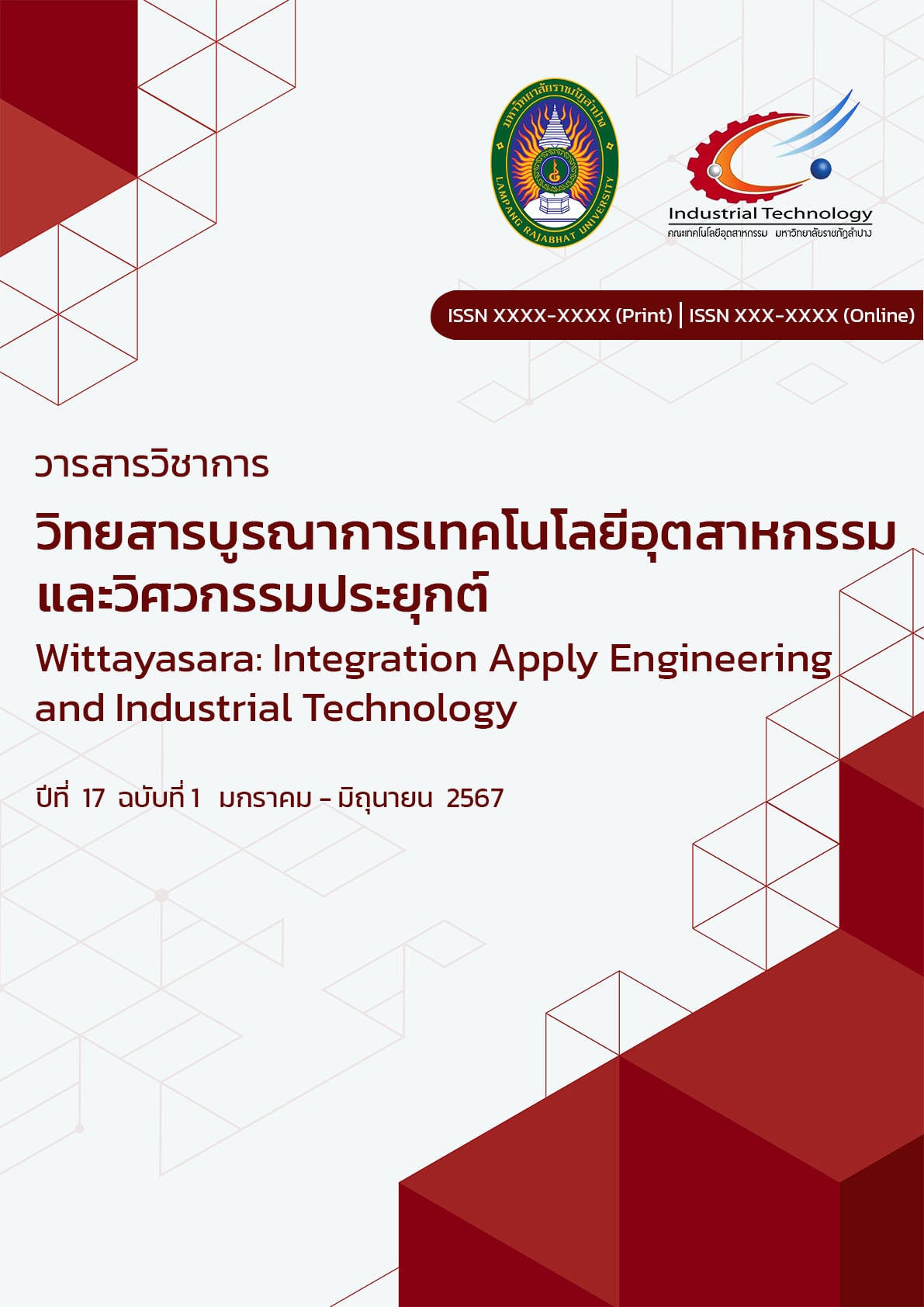Comparison of Gray Oyster Mushroom Production in a Smart Farm and Traditional Farm
Keywords:
Smart Farm, Gray Oyster Mushroom Production, Internet of Things TechnologyAbstract
This study, comparing gray oyster mushroom production in a smart farm and a traditional farm had two objectives: 1. To compare the mushroom production in a smart farm and a traditional farm; and 2. To compare the mushroom production from different arrangements of mushroom lumps. For this research, Internet of Things technology and measurement equipment were installed to control 4 factors of oyster mushroom production: 1. Relative humidity 70 - 90%; 2. Temperature 28 - 32°C; 3. CO2 content less than 2,000 ppm; and 4. Light 100 lux. The research design divided the smart farm into 4 zones to record the results of mushroom production in each zone. In zones 1A and 1B, the mushroom cultures were arranged in 2 layers vertically, with a gap of 1 layer, and in zones 2A and 2B, the mushroom clusters were arranged in the traditional way, by placing the mushroom clusters on top of each other vertically.
The mushroom production in the smart farm was higher than the traditional farm (24.18-26.51%). When adjusting the arrangement, 2 layers vertically, with a gap of 1 layer, it was found that production in the smart farm was higher than the traditional farm (33.81 - 35.86%). This shows that production in the smart farm was higher than the traditional farm and the arrangement of 2 layers, with a gap of 1 layer, gives better results than the traditional arrangement.
References
Chieochan, O., Saokaew, A. & Boonchieng, E. (2017). IOT for smart farm: A case study of the Lingzhi mushroom farm at Maejo University. Paper presented at the 2017 14th International Joint Conference on Computer Science and Software Engineering (JCSSE).
Fongngen, W., Pechhan, S. & Yajor, R. (2018). Application with the Internet of Things Technology Control in Smart Farms Mushroom. Journal of Technology Management Rajabhat Maha Sarakham University, 5(1), 172-182. (in Thai)
Hongyont, S. (2019). Cost Analysis and Finance Return of Oyster Mushroom Farm in Ubon Ratchathani. Journal of Graduate School, Pitchayatat, Ubon Ratchathani Rajabhat University, 14(2), 189-196. (in Thai)
Jeznabadi, E. K., Jafarpour, M. & Eghbalsaied, S. (2016). King oyster mushroom production using various sources of agricultural wastes in Iran. International Journal of Recycling of Organic Waste in Agriculture, 5(1), 17-24.
Kamonkunanon, S., Songneam, N., Supawantanakul, D. & Siringam, T. (2022). A Study of Factor of Production for Cool Group of Mushrooms in Smart Farm Using Internet of Things Technology. Loei Rajabhat University Research Conference 8th: Loei Rajabhat University. (in Thai)
Khambun, A., Singkhleewon, N., Thanasin, K. & Puttala, S. (2021). The Development of an Intelligent Mushroom Cabinet with Solar Energy. Phranakhon Rajabhat Research Journal: Science and Technology, 16(1), 27-40. (in Thai)
Office of the Royal Development Projects Board. (2012). Guide to growing economic mushrooms and native mushrooms (2nd Edition). Bangkok: Mind Create Advertising company Limited.
Payommai, T. & Wangkhuntod, S. (2023). Development of smart mushroom farm to increase the efficiency and value of mushrooms by using smartphone control for community enterprises in mushroom farming. Agriculture and Technology Journal, 4(2), 59-73. (in Thai)
Prikupets, L. B. (2018). Technological lighting for agro-industrial installations in Russia. Light & Engineering, 26(1), 7-17.
Raja, S. P., Rozario, A. R, Nagarani, S. & Kavitha, N. (2018). Intelligent Mushroom Monitoring System. International Journal of Engineering & Technology, 77(2.33), 1238-1242.
Sangpakornkij, T. (2013). Oyster mushroom. Bangkok: SE-ED Publishing. (in Thai)
Satun College of Agriculture and Technology. (2014). Mushrooms and the importance in mushroom production. [online], Available: http://www.satunatc.ac.th/lms/course/view.php?id=3. access on December 8, 2023. (in Thai)
Singjaroen, B. & Sakaew, S. (2016). Temperature and Humidity Control System in Mushroom Greenhouse. The 1st Ralamangala University of Technology Suvarnabhumi National Conference, 176-183. (in Thai)
Subedi, A., Luitel, A., Baskota, M., & Acharya, T. D. (2019). IoT Based Monitoring System for White Button Mushroom Farming. Paper presented at the Multidisciplinary Digital Publishing Institute Proceedings.
Sumonphan, E., Thongchai R., Khamchuen, C. & Viriyarattanakul, S. (2021). Controlling System of Bhutan Oyster Mushroom's Growth and Alert by Image Processing and Internet of Things. Science Technology and Innovation, 2(3), 1-10. (in Thai)
The National Science and Technology Development Agency. (2021). Collection of data on production and marketing of economic mushrooms and wild edible mushrooms in Thailand. [online], Available: https://waa.inter.nstda.or.th/stks/pub/2021/20210817-economic-mushroom-market.pdf. access on February 15, 2023. (in Thai)
Thongyothee, S., Dangton, W., Jeepetch, V., Wongniyom, A., Lomchangkhum, C. & Thongothee, C. (2023). Design of Temperature and Relative Humidity Test Kit for Grey Oyster Mushrooms Cultivation. Rajamangala University of Technology Tawan-ok Research Journal, 16(2), 24-34. (in Thai)
Toomthong, P., Sakaew, S., Niyomtong, P., Keeratiyadathanapat, N. & Suvarnakuta, N. (2021). A Study of Evaporative and Fogging Cooling System for Mushroom House. Industrial Technology Journal, 6(2), 33-40. (in Thai)
Youngkerd, N. & Sangdee, P. (2015). Mushroom production for sale. Bangkok: MIS Publishing. (in Thai)
Downloads
Published
Issue
Section
License
Copyright (c) 2024 Wittayasara: Integration Apply Engineering and Industrial Technology

This work is licensed under a Creative Commons Attribution-NonCommercial-NoDerivatives 4.0 International License.






